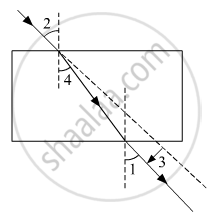Advertisements
Advertisements
प्रश्न
A star sometimes appears brighter and some other times fainter. What is this effect called? State the reason for this effect.
उत्तर
A star sometimes appears brighter and some other times fainter, this effect is called as twinkling effect. This effect arises due to atmospheric refraction. Our atmosphere is constantly moving. Light travelling from the stars gets bent in different directions making them twinkle.
संबंधित प्रश्न
What is atmospheric refraction? Use this phenomenon to explain the following natural events:
Advanced sun-rise and delayed sun-set.
Draw diagrams to illustrate your answers.
The correct sequencing of angle of incidence, angle of emergence, angle of refraction and lateral displacement shown in the following diagram by digits 1, 2, 3 and 4 is:

(a) 2, 4, 1, 3
(b) 2, 1, 4, 3
(c) 1, 2, 4, 3
(d) 2, 1, 3, 4
Due to atmospheric refraction of sunlight, the time from sunrise to sunset is lengthened by about:
(a) 6 minutes
(b) 2 minutes
(c) 4 minutes
(d) 5 minutes
We know that light refracts (or bends) when it goes from one medium to another. Now, the atmosphere contains only air. Then how does light get refracted on passing through only air in the atmosphere?
By how much time the day would have been shorter if the earth had no atmosphere?
State two effects produced by the scattering of light by the atmosphere.
What causes the scattering of blue component of sunlight in the atmosphere?
Explain why the planets do not twinkle but the stars twinkle.
Refraction of light by the earth’s atmosphere due to variation in air density is called ____________.
How does refraction take place in the atmosphere? Why do stars twinkle but not the planets?
